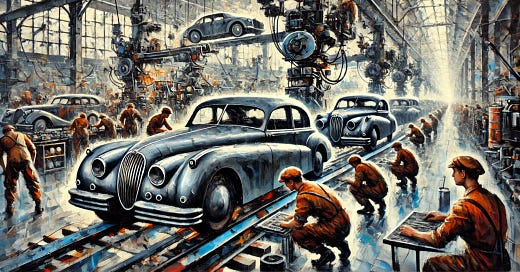GENCO MEMO-12-11-24: Jaguar's Unprecedented Gamble on Reinvention
Business Turnaround Month: No. 5 in the series.
We are close to halfway through the December Business Turnaround Series and I want to turn to perhaps the most audacious transformation attempt yet.
After exploring Barnes & Noble's local focus, mall brands' street-side renaissance, banks' café evolution, and Starbucks' return to roots, we examine Jaguar's extraordinary decision to essentially cease operations for over a year to completely reinvent itself.
Here is a video that will get you up to speed on what Jaguar is doing:
Now to my summary and takeaways:
The Bold Pause
In a move unprecedented in automotive history, Jaguar has almost completely halted production as of November 2024, planning to maintain this pause until at least 2025.
This dramatic step comes as the culmination of a long decline that has seen the iconic British brand's sales fall to about one-third of their 2017 peak.
For a company whose E-Type was once dubbed "the most beautiful car in the world" by Enzo Ferrari himself, this represents both an admission of failure and a brave bid for renewal.
The Path to Crisis
The story of Jaguar's decline is a cautionary tale about brand dilution and the perils of chasing volume over value.
The company's troubles can be traced through several key phases:
The Ford Years (1989-2008)
While Ford's ownership brought improved manufacturing facilities and significant investment, it also pushed Jaguar toward higher production volumes, moving away from its exclusive luxury positioning.
The resulting vehicles, often sharing platforms with Ford models, were seen as competent but lacking the distinctive character that had defined Jaguar.
The Tata Era and SUV Pivot
After Tata Motors acquired Jaguar (along with Land Rover) in 2008, the company attempted to follow market trends by introducing SUVs like the F-PACE and E-PACE.
While initially successful, this strategy ultimately faltered, particularly when competing against sister brand Land Rover's more authentic SUV credentials.
The EV Stumble
Jaguar's early entry into the electric vehicle market with the I-PACE in 2018 showed promise but failed to maintain momentum, largely due to lack of updates and clear strategic direction.
The Reinvention Strategy
Jaguar's new turnaround plan represents a fundamental rethinking of the brand's position in the automotive landscape.
Key elements include:
1. Return to Exclusivity
The company plans to reposition itself as a maker of ultra-luxury electric vehicles, with prices starting around $125,000 – deliberately positioned above Range Rover's territory.
2. Significant Investment
A planned $19 billion investment through 2028 will support the development of three new fully electric vehicles, beginning with a grand tourer launching in 2026.
3. Technical Innovation
The company is leveraging Tata Consulting Services' engineering capabilities to develop a dedicated electric architecture platform for its new vehicles.
4. Brand Revival
A new branding strategy and visual identity aim to reconnect with Jaguar's heritage while positioning it for a premium electric future.
Legal and Business Strategy Implications
When looking at it from a business and legal perspective, this transformation presents several fascinating considerations:
Intellectual Property Management: The challenge of protecting and leveraging historical brand assets while creating new ones for the electric era.
Supply Chain Reconstruction: The legal implications of completely restructuring supplier relationships during the production pause.
Employment Law: Managing workforce implications during the extended production halt and subsequent transformation.
Regulatory Compliance: Navigating the complex regulatory landscape of luxury electric vehicles across global markets.
Strategic Challenges
The plan faces several significant hurdles:
Market Positioning: The ultra-luxury EV space is becoming increasingly crowded with established players like Rolls-Royce, Bentley, and Aston Martin all moving into this segment.
Brand Perception: Overcoming historical reliability concerns while establishing credibility in the electric luxury space.
Technical Excellence: Achieving the necessary level of engineering sophistication to compete at the highest end of the market.
Market Timing: The risk of missing critical market opportunities during the extended production pause.
Key Lessons for Business Transformation
Jaguar's bold strategy offers several key insights for businesses considering dramatic transformation:
Strategic Pause: Sometimes stopping completely to reset can be more effective than attempting to transform while maintaining operations.
Heritage as Asset: The value of reconnecting with core brand values while evolving for the future.
Market Positioning: The importance of finding clear "white space" in the market rather than competing in overcrowded segments.
Investment Commitment: The need for substantial financial backing to support fundamental business transformation.
What makes Jaguar's transformation attempt particularly interesting is its parent company's strong position.
With Land Rover performing exceptionally well, generating over $2 billion in profits last fiscal year, Jaguar has the luxury of time and resources to attempt this dramatic reinvention. This financial cushion allows for a level of risk-taking that might be impossible for a standalone company.
This bold approach raises a provocative question for business leaders:
When faced with declining relevance in a changing market, is it sometimes better to stop completely and reset rather than attempt to transform while maintaining operations?
Jaguar's experiment may provide the answer in the years to come.
That is all.
Enjoy the rest of your week!




